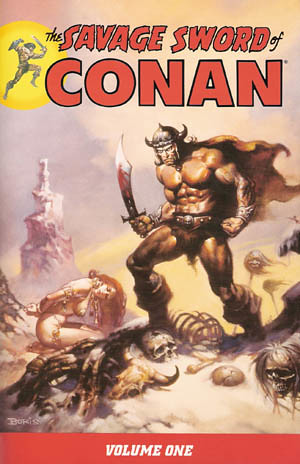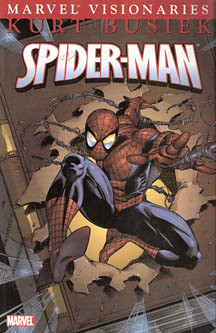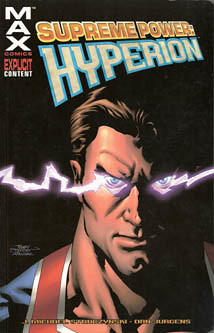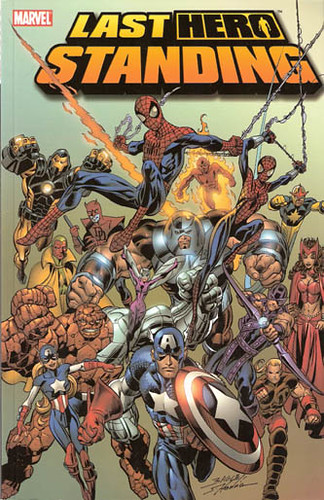Batman: Hush, v. 1
Collects: Batman #608-12 (2002-3)
Released: July 2004 (DC)
Format: 128 pages / color / $12.99 / ISBN: 9781401200602
What is this?: The villains in Gotham City seem strangely organized as Batman investigates a kidnapping that leads to a plot against him.
The culprits: Writer Jeph Loeb and penciler Jim Lee
Before various Crises and Grant Morrison hit Batman, the biggest story in Gotham was Batman: Hush.
Writer Jeph Loeb, penciler Jim Lee, and inker Scott Williams collaborated on a twelve-issue run on Batman, introducing a new, bandaged-swathed villain called Hush. In Batman: Hush, v. 1, however, Hush figures very little in the story. Instead, this volume mostly sets up the villain’s plan while giving Batman some evildoers to fight.
(An aside: When deciding whether to review the entire Hush storyline in one post or write a review on each of the softcover volumes, I opted for two separate reviews. This allows for me to review the first volume, and if someone opts to read Hush on that basis, they won’t be spoiled as much, no matter how much detail I go into.)
 Hush, v. 1, feels like a detective story. There is little of the actual character Hush here; there are suggestions that someone is pulling the strings of a few Gotham villains, like Poison Ivy, Catwoman, Killer Croc, and perhaps even LexCorp. There isn’t a payoff in v. 1 on the culprit — this is v. 1, after all, of two — so Hush, v. 1, is setup.
Hush, v. 1, feels like a detective story. There is little of the actual character Hush here; there are suggestions that someone is pulling the strings of a few Gotham villains, like Poison Ivy, Catwoman, Killer Croc, and perhaps even LexCorp. There isn’t a payoff in v. 1 on the culprit — this is v. 1, after all, of two — so Hush, v. 1, is setup.
On that score, it works, although you have to wonder how you top a Batman / Superman fight. (It’s a credit to Batman’s reputation that Loeb doesn’t have to explain why Batman has a plan to fight Superman, in Metropolis, on the spur of the moment.) Two storylines may be hard to swallow, however: Batman beginning a romance with Catwoman and the introduction of Bruce Wayne’s boyhood best friend, Dr. Thomas Elliot. The former isn’t so hard to understand; she’s Catwoman, he’s lonely, and there’s no Bat accessory that’s going to help with that. The introduction of a childhood friend who meant so much to Bruce is more difficult to swallow, however; in reading v. 1, you have to wonder why Loeb goes to so much trouble to introduce a surgeon with boyhood ties to Bruce.
Lee is … well, he does Jim Lee work. His name sells comic books — or so we’re told — and he’s been a sought-after talent for almost two decades now. Hush, v. 1, is just another line on his resume. His work is impressive, if a looking a bit staged at certain “cool” moments. Still, it’s easy to see why his work is so highly thought of — each character has what looks like an iconic look, but Lee’s designs feel fresh. The fight scenes are well staged, as well. There are the standard, long-legged cheesecake-ish shots — as I said about Joe Benitez’s work on Batman: Detective, there’s nothing remarkable about that in most superhero comics. Well, nothing remarkable except that Lois Lane wears a skirt a bit short for a career woman wanting to be taken seriously as a journalist, and Lee likes the butt shots of Huntress.
Hush, v. 1, is mostly fun, even if it seems Batman absorbs an absurd amount of damage. I have reservations about parts of it, but it looks great and feels like it’s building toward something big, which is exactly what Loeb and Lee are aiming for.
Rating: ![]()
![]()
![]()
![]() (4 of 5)
(4 of 5)
Labels: 4, Batman, Catwoman, DC, Gotham City, Hush, Jeph Loeb, Jim Lee, Metropolis, Poison Ivy, Scott Williams, Superman





 That’s what writer Paul Dini does in
That’s what writer Paul Dini does in  (3.5 of 5)
(3.5 of 5) Admittedly, Conan is the same character in each. This leads to the question, Which is superior?
Admittedly, Conan is the same character in each. This leads to the question, Which is superior? 
 (3.5 of 5)
(3.5 of 5)  It is depressing that it isn’t what I’m saying or how I’m saying it that brings visitors — it’s simply filling in alt tags.
It is depressing that it isn’t what I’m saying or how I’m saying it that brings visitors — it’s simply filling in alt tags. So let’s consider a book somewhere early — or perhaps even before — the slide began.
So let’s consider a book somewhere early — or perhaps even before — the slide began.  In Hero, superheroes begin disappearing — Wolverine, Spider-Man, the Thing, one of the Ladyhawks — and the other heroes blindly investigate. As more are abducted and the remaining heroes come closer to finding the truth, the missing heroes return as ‘90s version of themselves, albeit without pouches, spikes, or shoulder pads. No, they’re grittier and grimmer, and they are out for the blood of those they loosely define as villains. Meanwhile, the aged Captain America wrestles with failing abilities in an environment in which small failures could lead to death — his or another’s.
In Hero, superheroes begin disappearing — Wolverine, Spider-Man, the Thing, one of the Ladyhawks — and the other heroes blindly investigate. As more are abducted and the remaining heroes come closer to finding the truth, the missing heroes return as ‘90s version of themselves, albeit without pouches, spikes, or shoulder pads. No, they’re grittier and grimmer, and they are out for the blood of those they loosely define as villains. Meanwhile, the aged Captain America wrestles with failing abilities in an environment in which small failures could lead to death — his or another’s.